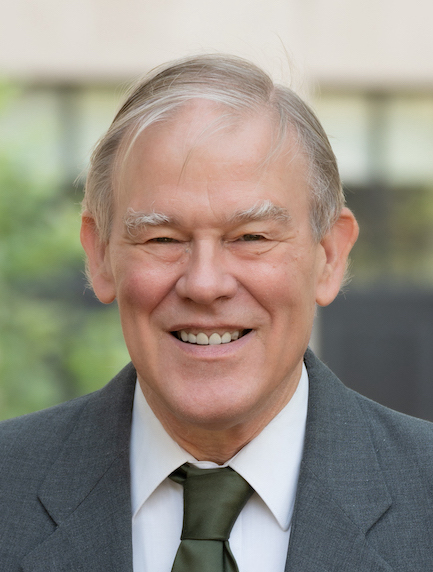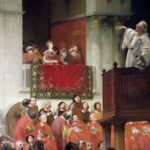Understanding Nicene Christianity and its importance for a truly Biblical faith was the topic of the First Annual Prince Georges Conference on Reformed Theology held at Greenbelt Baptist Church in Maryland late last month. Two earlier articles reviewed presentations there, the second of which reviewed presentations concerning the Nicene/Constantinopolitan Creed – the “Nicene Creed” recited in churches today – its doctrines of the Trinity and the Incarnation, and the relevance of these to monotheism, the deity of Christ, and the doctrine of salvation. A further lecture, by Craig Carter, Research Professor of Theology at Tyndale University in Toronto, Canada, discussed the Council of Chalcedon in A.D. 451, which defined more clearly what is meant in the creed by saying that Jesus Christ “came down from heaven … and became man.”
Heresies concerning the Trinity
Carter began by first pointing out three heresies concerning the Trinity that should be mentioned. The first is modalism. This holds that “God is really just one person.” He appears differently at different times. This is commonly expressed by saying that he appeared as the Father in the Old Testament, the Son in the New Testament, and the Holy Spirt in post-Biblical times. This heresy “fails to understand that God is three in one, always.” Secondly, subordinationism “is just a general term that includes Arianism.” It is any doctrine that says that “the Son and the Spirit are divine but not of the same being as the Father … [or of the same] glory and majesty as the Father.” Contemporary Jehovah’s Witnesses hold an Arian Christology, Carter observed. Thirdly, there is tri-theism. This is any doctrine of the Trinity that regards the three persons of the Trinity as three beings.
He said that during the twentieth century there has been greater emphasis on social relations in the Trinity “which verges on tri-theism.” But tri-theism is “basically polytheism.” The members of the Trinity are held to agree on everything, and work closely together, but as three separate centers of consciousness, it is hard to see how they are the same being. Tri-theism may specify three gods rather than some other number, but it is polytheism nonetheless. Carter claimed the novel The Shack, which rose to great popularity several years ago, depicts a tri-theist understanding of the Trinity. He pointed as well to Jurgen Moltmann as a prominent theologian who believes in social trinitarianism, which can be understood as tri-theist. It is a very appealing theology to people who want to advance harmony and social cooperation. He said that this type of theology is “very popular, and I expect it to grow in popularity.” All of these heresies we “can expect to see again and again in different forms, different angles.” A final point, Carter said, is that the orthodox definition is not so much a definition as it is a doctrine that “what was confessed to be true about God is not a contradiction.”
The Doctrine of God in the flesh
The doctrine of the Trinity would appear to be a consequence of the effort to understand the deity of Christ. Carter said that “what we know is that from the earliest times … from the first century,” from the ascension of Christ onward, Christians on the first day of the week “gathered to worship Jesus Christ as God.” A number of New Testament texts, cited in the second article in this series, clearly assert Jesus’ deity. (Jn. 1:1-3, Titus 2:11-14, Rom. 9:5) And others could be identified as well. But to explain how Jesus could be both God and man was “the unfinished business” of the First Council of Constantinople (A.D. 381). The doctrine of the Incarnation, expounded by the Council of Chalcedon (A.D. 451), explains, at least to some degree of intelligibility, how this is to be understood.
The Incarnation begins with the requirement that Jesus is both God and man and cites Jn. 1:14 to support this:
“And the Word was made flesh, and dwelt among us, (and we beheld his glory, the glory as of the only begotten of the Father,) full of grace and truth.”
God requires perfect obedience in the Old Testament, yet man is unable to give it. This is the “the great conundrum which is resolved by the Incarnation.” Because God possesses “infinite merit,” the sacrifice of himself will atone for the sins of mankind, reconciling them to God’s justice.
The Incarnation is a continuation of the salvation history of the Old Testament, the “mighty acts of God in history, and the mightiest act of all … is the Incarnation.” Carter cited “three statements about Jesus Christ” in the first chapters of the Gospel of John. First, the pre-incarnate Christ, the Son of God, was “in the beginning with God (Jn. 1:1-2),” and he spoke the world into existence. There is “a clear statement here of pre-existence. The story of Jesus did not begin with the man Jesus at birth. There is a pre-existent eternal Word, eternal Son, a Logos who always was and always will be.” Secondly, “John clearly identifies the one he calls the Light as Jesus (Jn. 1:9-10).” Thirdly, “the Word became flesh and dwelt among us (Jn. 1:14).” “Became” indicates that the eternal God entered the world, but before that “there was not any second of time in which the Word did not exist, but the Word was not always flesh.” The Word not being flesh from the creation of the world to Mary’s miraculous conception, and then being flesh thereafter is “an astonishing thing.” Carter asked how it was possible for God to become flesh if God is unchangeable.
Carter said that “change did happen … but that change did not occur in the immutable being of God.” He said that “if we go wrong here, we go wrong everywhere in our Christology.” One must have a correct understanding of the changelessness of God’s nature to understand the problem with which the Council of Chalcedon wrestled. He noted that “modern theology does get this wrong.” He said that the “result of this is heresy, and the loss of the doctrine of God in Christ.” We lose both the doctrine of Christ and the doctrine of God.
The Incarnation occurred “when the immutable, eternal God assumed human flesh into union with himself.” Carter said that Mary’s miraculous conception of Jesus can only be compared to God’s initial act of creation. The eternal Word assumed flesh, “without the eternal Word itself changing.” This is commonly referred to as “the hypostatic union.” Recall from the previous article in this series that “hypostasis” was the Greek word the Cappadocian Fathers chose to refer to each individual member of the Trinity. “This is the heart of the mystery,” Carter said.
Carter sees some analogy between the hypostatic union and the event of conversion experienced by believers. God becomes our refuge when we turn to him. There is no change in God, but a change in us. Similarly, when God created the world, God did not change, but the world came from non-being into being. When creatures interact, however, there is likely a change in both parties. A mother may give birth, but she is in some measure changed as well as her child.
The uniqueness of the Incarnation
Carter then moved into a discussion of philosophical theology. “Everything is a mixture of actuality and potentiality.” Any potentiality, however, must be actualized by something actual. This means that for anything to exist, there is a chain of causation preceding it. If this chain goes on forever, “there would never be anything at all,” Carter said. Thus, there must be a first cause for anything to exist, and this first cause cannot be at all potential, but entirely actual, i.e., “pure act.” This is a difference between the creator and his creatures. “There is an infinite qualitative difference” between the creator and his creation. Thus, “there are deep metaphysical reasons for believing that what we are told in Scripture is true.”
Carter observed that this concept of God is not a “cheap … superhero type god.” It is not a concept of deity such as one finds in the Greek pantheon. The “astonishing” claim of the New Testament, Carter said, “is that the man, Jesus of Nazareth is one with that First Cause.” Indeed, it is so difficult to comprehend that “no one could think it up.” The doctrine of the Incarnation was an entirely new development in religious history, Carter maintained.
The Council of Chalcedon had to deal with three doctrines. First, that God is one (monotheism). Secondly, that the one God exists in Trinity. Thirdly, that the second person of the Trinity, God the Son, took on flesh and became man. The word “became” raised concerns at the council that the first affirmation (monotheism and immutability) was being undermined by the third (the Incarnation).
“The definition of Chalcedon was given, not to provide a rational explanation of the mysteries, and it was not given to pry into the mysteries of Christ in such a way as to make him fully comprehensible to finite human beings. The purpose was more to build a fence around the mysteries to prevent well-meaning but unwanted efforts from destroying the doctrine of God in the process of affirming the doctrine of Christ.” Chalcedon claimed the Incarnation as the doctrine of the both the Old Testament prophets and the church fathers. More importantly, it was further claimed to be the doctrine of Christ himself.
Chalcedon was “a clarification of what was already believed, but not always understood correctly.” He said that “from this point on, you will find church after church … re-affirming the Nicene Creed.” In the High Middle Ages, Thomas Aquinas, for instance, viewed his understanding of the Trinity and the Incarnation as simply “handing on” what he had received. The Protestant Reformers likewise accepted the authority of the doctrines of Nicaea and Chalcedon. This was re-affirmed in the Protestant confessions, e.g., the Thirty-Nine Articles, the Heidelberg Catechism, and others express Trinitarian and Incarnational orthodoxy.
“What Chalcedon says is that Jesus Christ was one person … a union of the divine and human natures … [but] it involves no change the divine nature of the eternal Word itself” rather “the eternal Word assumes human nature into union with itself.” Since we cannot atone for our sins ourselves “therefore God had to become man in the person of Christ in order to die an atoning death. It was a death of a real man and also the death of a human nature united to the divine nature by means of mysterious and miraculous union that made it possible to say in a carefully worded sense that God died on the cross.”
The Christology of Chalcedon carefully defines the natures of Christ. Jesus was both fully divine and fully human, in union of being with the Father, “like us in all respects except for sin … The two natures are not to be divided or separated or confused or changed.” There is a single “one and the same person … [the] Lord Jesus Christ.”
Not present in the Chalcedonian formula “is any explanation of how” this union is possible. He observed that “at this heart of the creed is not an affirmation but a negation.” The divine and human natures are not two persons in Jesus Christ, but one. The two natures are not confused and not separated. God has not changed and will not change because of the Incarnation. Carter believes that the only thing in the physical world which is even somewhat like the Incarnation is the union of sperm and egg in human conception. The resulting individual cannot be divided into the father’s part and the mother’s part. Ordinary human beings, however, have only one nature. “The mystery here is how one person can have two natures.” Attempts to make this more comprehensible all deny either Jesus’ full deity or full humanity, and thus are heretical. “Chalcedon is telling what we have to believe to do justice to all of Scripture.” He said that all Scripture testifies to Jesus Christ.
Common Christological heresies
Carter then reviewed six heresies that historically have been advanced against the Incarnation. These include Docetism, which denies that Jesus had a real, physical body. Jesus therefore did not suffer on the cross. Carter said that there is a tendency in Docetism to see Jesus’ teaching rather than his sacrificial death as the “main point” of his messiahship. Secondly, Apollinarianism said that Jesus was not fully human. His body was human, but his mind was divine. This was known in the early centuries and re-appears from time to time. Thirdly, Ebionism holds that Jesus was not divine. The Ebionites were Jews in the first century who regarded Jesus as their leader, but saw him only as a great prophet, the messiah, a great spiritual leader, but not God. Fourth, Arianism holds that Jesus is in some sense divine, but inferior in being to God the Father. Fifth, Nestorianism held that Jesus was essentially two persons, a divine Son of God and a human Jesus of Nazareth. Finally, Eutychianism held that Jesus has only one blended nature, which was both divine and human, but with the divine nature essentially absorbing the human.
As for modern deviations from Chalcedonian doctrine, Carter said that in the last two hundred years kenotic christology has developed. “Kenosis” is emptying. Kenotic Christology takes Phil. 2:6-8 as its key text. This says regarding Jesus that
“although he existed in the form of God, did not regard equality with God a thing to be grasped, but emptied himself, taking the form of a bond servant, and made in the likeness of men. Being found in appearance as a man, he humbled himself by becoming obedient to the point of death, even death on a cross.”
This is taken to mean that Jesus gave up his divine attributes at the Incarnation. Thus, Jesus was not really divine on earth. Carter said this christology is popular, and he expects it to become more popular. What this means is that the very nature of God changed at the Incarnation, which is not really possible. It also overlooks that Jesus’ humiliation on earth was humiliation “precisely because he was God.” He said that “modern kenosis theory … shies away from the true scandal of the Incarnation, which is that God became flesh, and died for us, to save … sinful people.” If it is accepted that God has changed, many Biblical doctrines about God, such as aseity (self-existence) and perfection have been overthrown.
Carter said that the Chalcedonian formula means at least this: “whatever we say is true about either of the natures” that Jesus possesses “is true of the one person,” Jesus Christ. He gave the example of Jesus praying in Gethsemane. When he prayed in his human will he dreaded the cross. But his divine will is in perfect harmony with the will of the Father, which is really the same will as that of the Father. Jesus, having two natures, in fact had two wills. “It was his human will that changed,” Carter said. The Chalcedonian formula does not give us “a puzzle to solve, but a mystery to worship.”
Christology certainly has not pre-occupied the minds of American Evangelicals, at least at a popular level, although with the recent eternal subordination of the Son controversy, that may be changing. It is the doctrine of salvation has been the central concern. But as the Prince Georges’ conference clearly explained, the doctrines of the Trinity and the Incarnation are intimately tied to the doctrine of salvation. We need to correctly understand them, both to worship the true God and confess a doctrine adequate to salvation.
The final part of the conference was devoted to considering the limits of creeds, and questions regarding the creedal doctrines that were presented, and will be reviewed in a final article.
It can be viewed here.






Comment by Robert Landbeck on October 15, 2022 at 9:59 am
The problem with ‘creeds’ is that they are all human intellecutal constructs of theology. They are not of God! They are not revealed. And to presume otherwise may be the greatest self deception in the whole of human history. The future of religion will depend upon whether theology is even a valid human intellectual endeavor.
Comment by Sorry Robert, you are wrong on October 17, 2022 at 9:58 am
Questions for you sir: If there are no creeds or statements of faith with any validity then how do you explain the unexplainible to people who are not Christian? How do answer questions that have not been asked/answered in Scripture?
It seems like you are limiting what the Spirit can do in human beings to help them understand and spread the good news of Jesus Christ. Nobody thinks that the creeds are equal with Scripture or that Theology can be used by finite beings to completely understand the infinite, transcendent God. But they are tools to help understand and grow in God’s grace, especially in a much different world that the world of the 1st Century AD/CE.
The creeds our excellent author has been discussing are not perfect documents, but they are a help to make sure we do not fall away from our faith and follow what is wrong. Please compare what harm Sunni and Shia Islam do their false religion and those who follow it because they seem unable to come to any agreement about their faith than there is a god and Muhammad is his prophet.
Comment by David on October 17, 2022 at 3:35 pm
The Sunni/Shia divide recalls the Catholic/Protestant divide of earlier times. In Europe, this faded away as religion became less important.
Comment by Search4Truth on October 17, 2022 at 7:38 pm
‘Let’s just remember Proverbs 18:2.